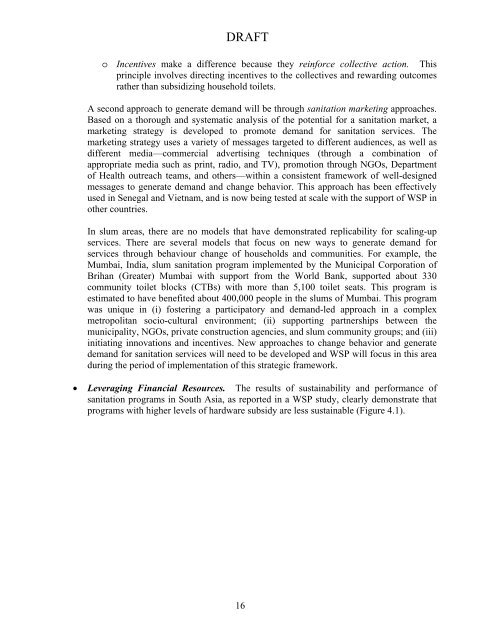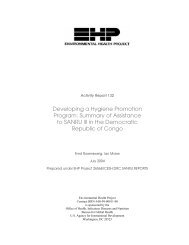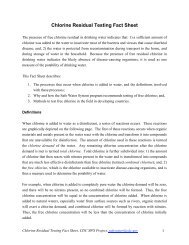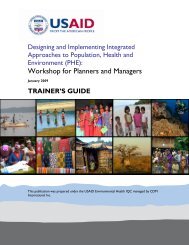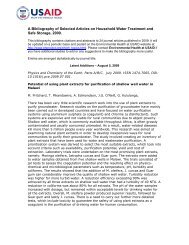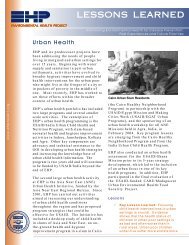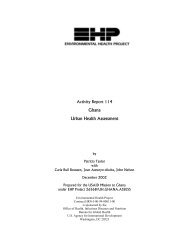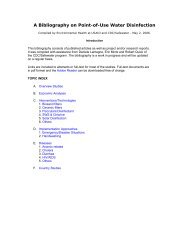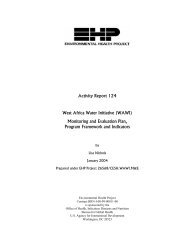The Water and Sanitation Program - Environmental Health at USAID
The Water and Sanitation Program - Environmental Health at USAID
The Water and Sanitation Program - Environmental Health at USAID
Create successful ePaper yourself
Turn your PDF publications into a flip-book with our unique Google optimized e-Paper software.
DRAFTo Incentives make a difference because they reinforce collective action. Thisprinciple involves directing incentives to the collectives <strong>and</strong> rewarding outcomesr<strong>at</strong>her than subsidizing household toilets.A second approach to gener<strong>at</strong>e dem<strong>and</strong> will be through sanit<strong>at</strong>ion marketing approaches.Based on a thorough <strong>and</strong> system<strong>at</strong>ic analysis of the potential for a sanit<strong>at</strong>ion market, amarketing str<strong>at</strong>egy is developed to promote dem<strong>and</strong> for sanit<strong>at</strong>ion services. <strong>The</strong>marketing str<strong>at</strong>egy uses a variety of messages targeted to different audiences, as well asdifferent media—commercial advertising techniques (through a combin<strong>at</strong>ion ofappropri<strong>at</strong>e media such as print, radio, <strong>and</strong> TV), promotion through NGOs, Departmentof <strong>Health</strong> outreach teams, <strong>and</strong> others—within a consistent framework of well-designedmessages to gener<strong>at</strong>e dem<strong>and</strong> <strong>and</strong> change behavior. This approach has been effectivelyused in Senegal <strong>and</strong> Vietnam, <strong>and</strong> is now being tested <strong>at</strong> scale with the support of WSP inother countries.In slum areas, there are no models th<strong>at</strong> have demonstr<strong>at</strong>ed replicability for scaling-upservices. <strong>The</strong>re are several models th<strong>at</strong> focus on new ways to gener<strong>at</strong>e dem<strong>and</strong> forservices through behaviour change of households <strong>and</strong> communities. For example, theMumbai, India, slum sanit<strong>at</strong>ion program implemented by the Municipal Corpor<strong>at</strong>ion ofBrihan (Gre<strong>at</strong>er) Mumbai with support from the World Bank, supported about 330community toilet blocks (CTBs) with more than 5,100 toilet se<strong>at</strong>s. This program isestim<strong>at</strong>ed to have benefited about 400,000 people in the slums of Mumbai. This programwas unique in (i) fostering a particip<strong>at</strong>ory <strong>and</strong> dem<strong>and</strong>-led approach in a complexmetropolitan socio-cultural environment; (ii) supporting partnerships between themunicipality, NGOs, priv<strong>at</strong>e construction agencies, <strong>and</strong> slum community groups; <strong>and</strong> (iii)initi<strong>at</strong>ing innov<strong>at</strong>ions <strong>and</strong> incentives. New approaches to change behavior <strong>and</strong> gener<strong>at</strong>edem<strong>and</strong> for sanit<strong>at</strong>ion services will need to be developed <strong>and</strong> WSP will focus in this areaduring the period of implement<strong>at</strong>ion of this str<strong>at</strong>egic framework.• Leveraging Financial Resources. <strong>The</strong> results of sustainability <strong>and</strong> performance ofsanit<strong>at</strong>ion programs in South Asia, as reported in a WSP study, clearly demonstr<strong>at</strong>e th<strong>at</strong>programs with higher levels of hardware subsidy are less sustainable (Figure 4.1).16


